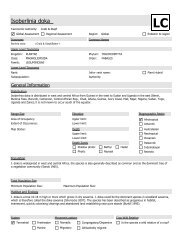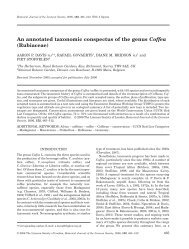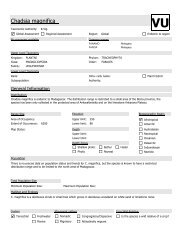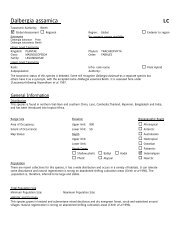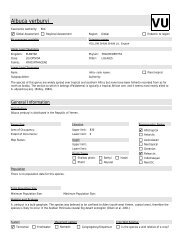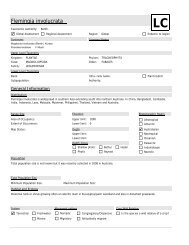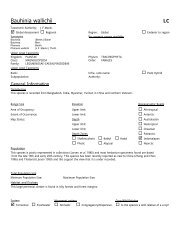Indigofera intricata - Sampled Red List Index for Plants
Indigofera intricata - Sampled Red List Index for Plants
Indigofera intricata - Sampled Red List Index for Plants
You also want an ePaper? Increase the reach of your titles
YUMPU automatically turns print PDFs into web optimized ePapers that Google loves.
<strong>Indigofera</strong> <strong>intricata</strong><br />
LC<br />
Taxonomic Authority:<br />
<br />
Global Assessment<br />
Boiss.<br />
<br />
Regional Assessment<br />
Region:<br />
Global<br />
<br />
Endemic to region<br />
Synonyms<br />
Common Names<br />
UZLIM<br />
Arabic<br />
Upper Level Taxonomy<br />
Kingdom: PLANTAE Phylum: TRACHEOPHYTA<br />
Class: MAGNOLIOPSIDA<br />
Order: FABALES<br />
Family: LEGUMINOSAE<br />
Lower Level Taxonomy<br />
Rank:<br />
Subpopulation:<br />
Infra- rank name:<br />
Authority:<br />
Plant Hybrid<br />
General In<strong>for</strong>mation<br />
Distribution<br />
Species distributed in Middle East, Iran, Oman, Pakistan, South Yemen, United Arab Emirates, Qatar and Somalia.<br />
Range Size<br />
Area of Occupancy: Upper limit: 500<br />
Extent of Occurrence:<br />
Map Status:<br />
Population<br />
Elevation<br />
Lower limit: 0<br />
Depth<br />
Upper limit:<br />
Lower limit:<br />
Depth Zones<br />
Shallow photic<br />
Photic<br />
Bathyl<br />
Abyssal<br />
Hadal<br />
Biogeographic Realm<br />
Afrotropical<br />
Antarctic<br />
Australasian<br />
Neotropical<br />
Oceanian<br />
Palearctic<br />
Indomalayan<br />
Nearctic<br />
The total population size of this species is not known. However, recent surveys in 2009 suggest 20 plants from United Arab<br />
Emirates, from Sharjah, in the middle of its range (MSBP 2010).<br />
Total Population Size<br />
Minimum Population Size:<br />
Maximum Population Size:<br />
Habitat and Ecology<br />
<strong>Indigofera</strong> <strong>intricata</strong> is a procumbent to postrate perennial herb which occurs in gravel plain, in association with Panicum,<br />
Crotalaria, Convolvulus and date palms (MSBP 2010).<br />
System<br />
<br />
Terrestrial<br />
<br />
Freshwater<br />
Movement pattern<br />
Nomadic Congregatory/Dispersive<br />
<br />
Crop Wild Relative<br />
Is the species a wild relative of a crop
Marine<br />
<br />
Migratory<br />
<br />
Altitudinally migrant<br />
Growth From<br />
Forb or Herb<br />
Definition<br />
Biennial or perennial herbacaeous plant, also termed a Hemicryptophyte<br />
Threats<br />
This taxon is not considered to be affected by any major threats across its whole range, however it is grazing-sensitive (Barker<br />
2008) and it is present in areas which are subjected to intense grazing in Somalia.<br />
Past Present Future<br />
1 Habitat Loss/Degradation (human induced) <br />
1.1 Agriculture <br />
1.1.4 Livestock <br />
13 None <br />
Conservation Measures<br />
Center <strong>for</strong> Biosaline Agriculture (ICBA) has prepared a plan to collect and conserve the native species of economic importance in<br />
which list I. <strong>intricata</strong> is included. Due to its natural adaptation to the arid desert climate, important to collect and conserve this<br />
species among others to be able to use them in future mitigation and rehabilitation plans (Rao and Shahid, 2008). Seeds have<br />
been collected as part of the Millennium Seed Bank Project. It is not known to occur in any Botanical Garden.<br />
In Place Needed<br />
3 Research actions <br />
3.5 Threats <br />
3.9 Trends/Monitoring <br />
4 Habitat and site-based actions <br />
4.4 Protected areas <br />
5 Species-based actions <br />
5.1 Re-introductions <br />
5.7 Ex situ conservation actions <br />
5.7.2 Genome resource bank<br />
<br />
Countries of Occurrence<br />
Year<br />
Round<br />
PRESENCE<br />
Possibly<br />
extinct<br />
Extinct<br />
Presence<br />
uncertain<br />
Native<br />
ORIGIN<br />
Breeding Nonbreeding<br />
Passage<br />
Season<br />
only migrant<br />
season only<br />
Introduced Re- Vagrant Origin<br />
Introduced uncertain<br />
Iran, Islamic Republic of <br />
Oman <br />
Pakistan <br />
Qatar <br />
Somalia <br />
United Arab Emirates <br />
Yemen <br />
General Habitats Score Description Major<br />
Importance
General Habitats Score Description Major<br />
Importance<br />
4 Grassland 1 Suitable<br />
Unset<br />
4.4 Grassland - Temperate 1 Suitable<br />
Unset<br />
6 Rocky areas (eg. inland cliffs, mountain peaks) 1 Suitable<br />
Unset<br />
8 Desert 1 Suitable<br />
Unset<br />
Species Utilisation<br />
<br />
Species is not utilised at all<br />
Purpose / Type of Use<br />
Subsistence National International<br />
16. Other <br />
2. Food - animal <br />
3. Medicine - human and veterinary <br />
Some of the native species in the United Arab Emirates are important due to their natural adaptation to the local environment<br />
(arid desert climate), such as I. <strong>intricata</strong>. They will be of great value <strong>for</strong> various uses such as the rehabilitation of degraded<br />
rangelands, landscaping and others, (Rao and Shahid, 2008). The species has been also collected due to its medicinal<br />
importance (Nadaf et al. 2003).<br />
Trend in the level of wild offtake/harvest in relation to total wild population numbers over the last five years:<br />
Trend in the amount of offtake/harvest produced through domestication/cultivation over the last five years:<br />
CITES status: Not listed<br />
Unknown<br />
Unknown<br />
IUCN <strong>Red</strong> <strong>List</strong>ing<br />
<strong>Red</strong> <strong>List</strong> Assessment:<br />
(using 2001 IUCN system)<br />
Least Concern (LC)<br />
<strong>Red</strong> <strong>List</strong> Criteria:<br />
Date Last Seen (only <strong>for</strong> EX, EW or Possibly EX species):<br />
Is the species Possibly Extinct Possibly Extinct Candidate <br />
Rationale <strong>for</strong> the <strong>Red</strong> <strong>List</strong> Assessment<br />
I. <strong>intricata</strong> has been described as a slow-growing graze-sensitive. However, it has a wide range of distribution and the population<br />
is believed to be stable at present, there<strong>for</strong>e, is listed as Least Concern.<br />
Reason(s) <strong>for</strong> Change in <strong>Red</strong> <strong>List</strong> Category from the Previous Assessment:<br />
Genuine Change<br />
Nongenuine Change<br />
Genuine (recent)<br />
Genuine (since first assessment)<br />
Current Population Trend: Stable Date of Assessment: 23/08/2010<br />
Name(s) of the Assessor(s): Lopez, L.<br />
Evaluator(s):<br />
New in<strong>for</strong>mation<br />
Knowledge of Criteria<br />
Incorrect data used<br />
previously<br />
Taxonomy<br />
Criteria Revisio<br />
Other<br />
<br />
No Change<br />
<br />
<br />
Same category<br />
and criteria<br />
Same category but<br />
change in criteria
Evaluator(s):<br />
Notes:<br />
% population decline in the past:<br />
Time period over which the past decline has been measured <strong>for</strong><br />
applying Criterion A or C1 (in years or generations):<br />
% population decline in the future:<br />
Time period over which the future decline has been measured <strong>for</strong><br />
applying Criterion A or C1 (in years or generations):<br />
Number of Locations:<br />
Number of Mature Individuals:<br />
Severely Fragmented:<br />
Bibliography<br />
Barker, J.R., Thurrow, T.L. and Herlocker, D.J., 1990, Vegetation of pastoralist campsites within the coastal grassland of central<br />
Somalia., African Journal of Ecology4, 291-297, ,<br />
MSBP, 2010, Millennium Seed Bank Project. Seed Bank Database. Royal Botanical Gardens, Kew., , ,<br />
Nadaf, S.K., Al-Farsi, S.M. and Al-Hinai, S.A., 2002-2003, Germplasm Collection of Rangeland Forage and Medicinal Plant Species<br />
in North Oman, ICARDA-APRP, , Ministry of Agriculture & Fisheries,<br />
Rao, N.K. and Shahid, M., 2008, Collecting Germoplasm of Native <strong>Plants</strong>, Biosalinity News, Newsletter of the International Center<br />
<strong>for</strong> Biosaline Agriculture4, 2, ,<br />
Walker, J. et al., 2007, Qatar, Oman, UAE and Arabian Peninsula (Lonely Planet Multi Country Guide), 272, Lonely Planet<br />
Publications,



